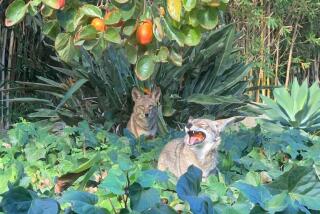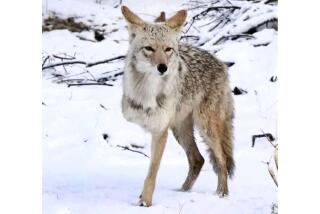These Birdies Are Most Unwelcome
- Share via
The American coot. By definition, Fulica americana is a black, ducklike migratory water fowl that ranges from British Columbia to South America, passing through Southern California each winter like an uninvited in-law.
It’s not particularly attractive, isn’t all that graceful and, depending on whom you talk to, is either crafty as a fox or dumb as, well, an old coot.
But on one thing virtually everyone who operates golf courses in this part of the world can agree: The coot can be a nuisance that keeps sticking its beak where it isn’t welcome.
As Southern California develops more land and natural habitat for migratory birds disappears, coots look at golf course lakes and ponds like four-star resorts. There’s water, ready food and not a lot of natural predators.
Coots appear in force some time in October, stay long enough to denude fairways and convert putting greens to minefields with their droppings, then in April largely disappear.
“It’s amazing,” says Dave Johansen, superintendent of Tijeras Creek Golf Course in Rancho Santa Margarita. “They’ll take the grass right down to the dirt. They’re worse than a herd of cows.”
Virtually no course that has freshwater ponds on it in this area is immune, but the problem is most severe for layouts that haven’t been able to reduce the coot population, seasonal though it may be.
“You can tolerate a few out there,” Johansen says. “When you get to five-six-seven hundred, then you have a problem.”
Los Serranos Golf Course in Chino Hills has a problem. Its coot population this past winter reached about 1,000.
“They do so much damage to the turf,” said Jim Hall, assistant superintendent for the North Course at the 36-hole Los Serranos facility.
“To us, they’re considered a pest; they don’t do anything good for the golf course.”
Recognizing the problem is easy; solving it isn’t. There are nearly as many methods to deal with coots as there are coots themselves. None of those methods is universally effective, though one practice--the use of trained dogs to herd the birds--is gaining in popularity.
Shooting or poisoning the birds, after getting a permit through the U.S. Fish and Wildlife Service, certainly eliminates the problem. But the permit process is sometimes cumbersome and killing the birds often meets with impassioned resistance from animal rights groups or residents near the course.
Several other methods can provide temporary relief, including posting fake owls around ponds, discharging gas cannons to frighten off the coots, tranquilizing them before transporting them to remote areas and building short wire fences around sensitive areas to keep the birds out.
Each of those methods, though, seems to provide only passing help.
The coots quickly get used to the deterrents, and transplanted birds are replaced by new ones.
“They’re smart birds, they catch on pretty quickly,” says Scott Williams, superintendent at Annandale Golf Club in Pasadena.
Other course managers have a slightly different take, mentioning that the birds are as likely to repeatedly walk into a small barrier as to simply hop over. “They’re not too bright,” says Los Serranos head superintendent Steve Hall. “And they’re very stubborn.”
There are also companies that manufacture chemical repellents, though many course officials say they are expensive and require almost daily applications. Others have tried spraying grape juice to make the grass acidic, or spicy liquids to make it less appealing.
“We’ve sprayed Tabasco sauce and pepper,” Tijeras Creek’s Johansen says. “When we did the Tabasco, the coots just followed along right behind the sprayer.”
Says Hall: “There’s no easy answer for everyone right now. If there was, we’d all be using it.”
Rather than wage the losing battle to eliminate the birds altogether, some courses are simply trying to manage them. And that often involves using trained dogs that can direct the birds away from greens and fairways.
Johansen uses a chocolate Labrador named Bogey to chase the birds back into the water or to areas where they can’t do much damage. Of course, that requires a person to be with the dog to direct him. Some courses are reluctant to devote an employee to coot patrol and spend several thousand dollars for a trained dog. And having the dog working on site 24 hours a day is unrealistic.
But at Glen Annie Golf Club in Goleta, a border collie named Annie, who lives with superintendent Vince Gilmartin, is a complete success story. “She doesn’t harm the birds or even get close; she just herds them back toward the water,” says Gilmartin, who considers Annie a family pet as well as a valued employee.
“The coots are not comfortable coming off the water to eat during the day, and at night they don’t like to come out of the water.
“Four and a half months ago, we had about 150 birds. The population disappeared in about three weeks. She eliminated the problem.”
The case at Glen Annie is exceptional, because coots are difficult birds to run off altogether. They like to retreat into the water and stay there. And they also can come in waves; the same force of birds on your course one week might be almost entirely different from the group a week later. But they can be managed to a degree.
Barbara Ligon, who runs Seclusival Kennel in Shipman, Va., and was one of the first trainers to school border collies exclusively for bird maintenance, ships upward of 50 highly trained collies a year all across the country.
Many of those dogs are trained to control Canada geese, which afflict golf courses elsewhere much the way coots do in Southern California. Many courses have rid themselves of geese populations with the border collies, which can cost $4,000 or more apiece, but coots are a little stickier problem.
“Coots are pretty dumb birds; they don’t fly off like geese,” Ligon says. “We’ve sold some dogs in California for coots, and the people have been pleased they’ve kept the coots in the water, away from their greens, at least. . . .
“So many people don’t want the nuisance of the birds, but they don’t want to kill them. These dogs won’t hurt the birds, they just herd them to a more desirable place.”
More to Read
Sign up for The Wild
We’ll help you find the best places to hike, bike and run, as well as the perfect silent spots for meditation and yoga.
You may occasionally receive promotional content from the Los Angeles Times.







